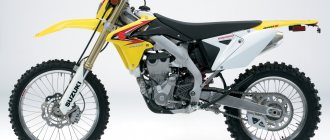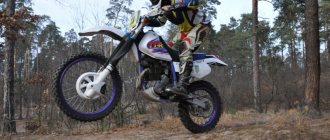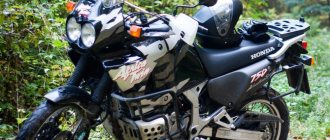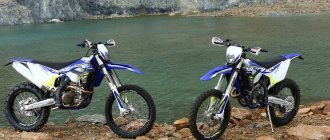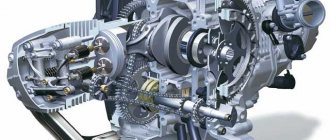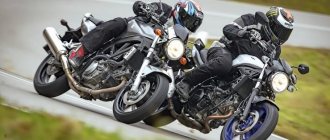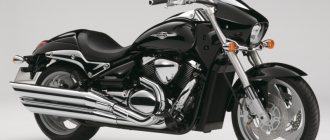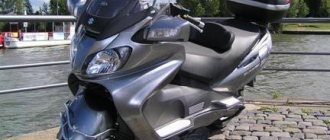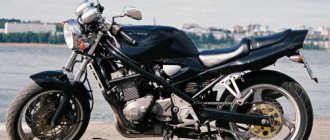Seeing the success that Kawasaki's line of Zizers (Kawasaki ZZR) received in the sports touring class, Suzuki representatives decided to keep up. Three years after the launch of competitors' models, in 1993 The Suzuki RF 400R model is introduced to the Japanese public. Just like the Zizers, in addition to the internal one, another version is put on the conveyor - with a 600 cc engine - for export.
The development turned out to be successful, the 400 cc bike sold no worse than its competitors, and later even managed to outperform them. Initially, the motorcycle was assembled on engines from Jixer (Suzuki GSX-R 400), later the line was divided into 2 directions. The second direction began to receive engines from the Suzuki GSF 400 Bandit .
Having the same parts as a more powerful model, the bike turned out to be practically indestructible. It was collected over 7 years. In 2000, the last Suzuki RF 400R rolled off the assembly line.
RF400 design
The design of the “four hundred” is based on a steel frame of a diagonal type.
For a road and at the same time sports bike, the developers decided to use steel. This solution:
- makes the structure heavier:
- makes it more durable;
- reduces the price of the final product.
For the latter, they also did not use any progressive, but untested solutions in the suspension.
The front wheel used a conventional telescopic fork (stay diameter 41 mm , stroke 120 mm ). Rear - one shock absorber on a pendulum basis (travel 125 mm ). From the settings we made adjustments for preload and rebound in the rear. The bikes of the first years also had the ability to adjust the fork preload, but a study of demand showed that this was not used and since 1995 it has been fixed , which again made it possible to reduce the price of the motorcycle.
Front fork.
Rear shock absorber.
The features of the bike include additional glove compartments in the front, a large windshield (like for sports), and a comfortable seating position.
Exterior
The model stands out from the crowd of competitors with characteristic “gills” on the sides for additional engine cooling. The decision turned out to be successful; the entire Suzuki RF line acquired it.
Front end
Low beam.
Headlight close-up.
Gills on plastic.
Steering wheel and mirrors.
- The large fender is tightly pressed to the 17-inch wheel . Above it is a small technological opening for air intake. The feathers behind the body kit are practically invisible. The last one is large, visually divided into 2 parts - the upper one with optics, glass mirrors, and the lower one, running along the motor. The dividing line is a design solution of the line, repeated on all older models.
- Here, at the level of this visual break, there are direction indicators . No frills, round buildings on their risers. Yellow in front, black in back. When trying to pack the bike, they are protected by a fault.
- The head optics are made in the form of one small square headlight . Interestingly, its size is directly proportional to the engine volume - at 600 cubic meters it is larger. There is practically no plastic underneath (before separation), above it the windshield continues, tilted back in a sporty manner. Due to the mounting, the mirrors are widely spaced, the viewing angle is good, and they do not protrude beyond the grips.
Dashboard
The release of 2 models at once had an impact here too. All blocks are the same, except that the marks on the speedometer are different.
The instrument panel is completely analogue, with four dial indicators and a block of signal lights.
This model has a speed of up to 190 km/h . In addition to the speedometer, there is a tachometer and an oil pressure indicator in front of the driver. The revolutions are marked up to 15x1000 , red from 13.5x1000 , the developers recommend 11x1000 .
All indicator lights are in a row, above the tachometer. The set is standard:
- neutral;
- turns;
- low fuel.
Back view
Rear optics.
Separate seats.
Fuel tank.
Trim on the tank.
- A motorcycle tightly sewn into plastic looks more like a sports bike . And there aren’t any tourist-specific features here either. As users note, the ergonomics of the model turned out to be unusual - neither classic nor sporty, but this does not affect the controls.
- The design of the rear optics is standard - the stop/marker is in the stem, there is a mudguard underneath, the turn indicators protrude beyond the bike using a metal strip on the mudguard. Here below is the number.
- There is no trunk , but there is space behind the second number, you can install it if you wish. Each passenger has his own saddle. The companion sits slightly higher than the driver. There is a handle for it and footrests are provided.
- The fuel tank looks huge , but holds only 17 liters , of which 3 liters is reserve, according to the standard. The head, as usual, is closed with a hatch, under which the lid itself is on the key. It is flat, the bag fits on the tank without any problems, but since it is located almost in front of the driver, holding the navigator in it can be inconvenient.
Suzuki RF 400
Brief review of Suzuki RF 400
The Suzuki RF 400 sports touring motorcycle model was released as a competitor to the super popular Kawasaki ZZ-R400. One of the reasons for the popularity of this Kawasaki model was the combination of low price, sporty appearance and the “comfort” characteristic of classic road bikes, and Suzuki decided to go the same way, taking as a basis the frame from the export Suzuki RF 600 and placing in it the engine from the Suzuki GSX sports bike. R 400 (later the RF was also equipped with an engine from the “red-headed” Suzuki GSF 400 Bandit; externally, these versions of the RF 400 are distinguished by red cylinder heads, red brake discs and “VC” stickers). As for the technical characteristics of the RF 400, they are almost identical to those of other 400 cc Japanese motorcycles with inline 4-cylinder engines.
During production, the motorcycle was modernized several times. The first generation of the RF 400 was equipped with engines from the GSX-R400, but since 1994, in parallel with this modification, the second generation went into production - the RF 400VR, with the aforementioned engine from the “red-headed” bandit. The exhaust has also been changed, becoming stainless. Since 1995, the model has received a modified dashboard, passenger footrests, a new subframe and an electronic speedometer drive, and also lost the ability to adjust the fork pretension. Since 1997, only versions with engines from the GSF 400 Bandit have been produced.
Similar motorcycles:
- Kawasaki ZZ-R 400
Technical characteristics of Suzuki RF 400
- Years of production: 1993-2000
- Class: sport-tourist
- Frame: diagonal steel
- Engine: 4-stroke, 4-cylinder, in-line
- Engine capacity, cubic meters see: 398
- Cooling: air-oil
- Valves per cylinder: 4
- Fuel supply: 4 carburetors
- Power: 53 hp at 11000 rpm
- Torque: 38 Nm at 9500 rpm
- Maximum speed, km/h: 215 (with speed limiter - 180)
- Acceleration from 0 to 100 km/h: ~4.9 seconds
- Transmission: 6-speed
- Wheel drive: chain
- Front tire: 120/70-17
- Rear tire: 160/60-17
- Front brakes: 2 discs 298 mm, 4-piston calipers
- Rear brakes: 1 disc 240 mm, 2-piston caliper
- Front suspension: telescopic fork (with pretension adjustment until 1995)
- Rear suspension: adjustable preload and rebound monoshock
- Gas tank volume, liters: 17
- Fuel consumption at 110 km/h, liters: ~5
- Dry weight, kg: 186
Pros and advantages of Suzuki RF 400
- Smooth ride thanks to comfortable suspension
- Comfortable fit
- Excellent wind protection
- Availability of a convenient glove compartment (since 1995)
- Efficient brakes
Pros and cons of the Suzuki RF 400
- Heavy weight
- Capricious carburetors, very demanding on correct settings
- Weak traction at low speeds
- Demanding on fuel quality
Specifications
Cylinder block.
An exhaust manifold.
Filler plug.
Cooling radiator.
Dividing the model into two directions allowed the bikes of the new wave to get good traction at the bottom, but this did not affect the overall picture. The Dzhikser engine had 4 strokes , 4-cylinders with an in-line arrangement and could not jump higher than its head:
- Working volume - 398 cm3.
- Power - 53 hp
- Maximum torque - 37.0 Nm.
- Number of valves - 16 (4 per cylinder).
- Cooling is liquid.
- Fuel supply - Mikuni carburetor.
- Ignition is transistorized.
- Start - electric starter.
Users note that the bike is quite picky about fuel quality. AI-92 accepts, but goes reluctantly.
Stock muffler.
Direct flow option.
Transmission and clutch
The motorcycle was equipped with a 6-speed gearbox. According to users, fast dynamics are not for this box. Gear ratios are spread across the entire rev range. It works well, switches clearly. True, neutral is sometimes difficult to catch.
- Multi-plate clutch , oil bath, power transmission - cable.
- Main drive - chain.
The chain is covered with a protective shield on top.
Brakes
Disc hydraulics are supported by 2-piston calipers. The only difference is the diameter and number of disks.
Front brakes.
Rear brake.
Front: brakes
- number of disks - 2;
- diameter - 290 mm;
- support - 2-piston.
Rear brakes
- number of disks - 1;
- diameter - 240 mm;
- support - 2-piston.
No options provided.
Release history
The Suzuki Vandit 400 motorcycle began to be produced from the assembly line in 1989. This model appeared on the roads of our country in 1991.
1989
BANDIT 400 1989
BANDIT 400 1989
Model features
- The cylinder head is gray.
- Black color and applied blue sparkle.
- Red color.
- Wheels are white.
- The front fork is brown.
Specifications
| Release | 1989 |
| Number of cylinders | 4 |
| Number of cycles | 4 |
| Engine displacement | 398 |
| Power | 59 hp |
| Compression ratio in cylinders | 11,8 |
| Number of valves | 4 per cylinder |
| Cylinder diameter | 56 mm. |
| Carburetors | 4 per cylinder |
| Cooling | liquid |
| Number of gears | 6 |
| Drive unit | chain |
| Gas tank capacity | 16 l. |
| Fuel consumption | 5-6 l. per 100 km. |
| Weight without gasoline | 172 kg. |
| Maximum speed | 190 km per hour. |
| Acceleration up to 100 km. at one o'clock | 5-6.5 s. |
1990
It is considered a luxury modification of the bike. The suspension has been modernized and become more rigid.
Read other motorcycle reviews Full review of the Kawasaki Ninja 300 motorcycle
Peculiarities
- The fork is painted silver.
- The engine shields are polished.
- Color – silver-blue.
1991
Differences between “red-headed” and “gray-headed”
The second series of modifications of Suzuki Vandit 400 motorcycles are “red-headed”.
The difference between the new copies is that they are equipped with an engine with variable valve timing, which automatically “expands” when the engine reaches 8000 rpm and as a result, the power and “agility” of the bike significantly increases. This innovation has greatly increased the popularity of motorcycles of this class in the world.
Some photos of the 1991 model
GSF 400 Bandit Limited V 1991
BANDIT 400V 1991 (Japan)
BANDIT 400 Limited 1991 (Japan)
BANDIT 400 Limited V 1991 (Japan)
Features of the 1991 model release
- Silver fork.
- The block head is painted red.
- Black motor shields.
- The color of the luxury version is silver-red or silver-blue.
- Regular model in red or black.
It was this year that the massive export of “Bandit” to Europe began. Moreover, the Japanese produce modifications for specific countries, but these are mainly modifications in the coloring and standardization of some elements of the bike.
There are also design features of models supplied to certain countries. For example, the bike comes to Germany with a 50 hp engine. and with round rearview mirrors. And to England with a single disc brake on the front wheel.
From now on, you can easily order a variety of technical and tuning spare parts for motorcycles in this series.
1992-1994
In 1993, Japanese legislation underwent changes, according to which motorcycles with a displacement of up to 400 cm3. must have a power of up to 53 hp. In this regard, changes have been made to the electronics of the bike, limiting speed capabilities to 180 km per hour and power to 53 hp.
Several photos of models 1992-1994
Suzuki GSF 400 Bandit 19
Suzuki GSF 400 Bandit 1994
1995
This year, the Japanese carried out another modernization of the Bandit. First of all, this is a more advanced design of the model.
The engine remains unchanged, but the chassis has been lightened, resulting in a shorter wheelbase of the motorcycle.
The biker’s comfort during operation has also improved, since the designers have equipped a four-liter trunk under the driver’s seat.
BANDIT 400V-2 1995 (Japan)
Read other motorcycle reviews Detailed review of the Honda PCX150 scooter
BANDIT 400V 1995
Features of the 1995 model
- The front fork has a silver tint.
- Wheels are black.
- Motor covers are anodized.
- The driver's seat is combined with the passenger seat.
- The pendulum is made of aluminum.
- The brackets for the footrests have been changed and become more convenient.
- The weight of the motorcycle has decreased by 5 kg.
Driving performance
The maximum speed announced by a company representative is 190 km/h . The bike has become one of the few where the maximum mark on the speedometer corresponds to the declared data.
Despite the opinion of users about poor dynamics, the motorcycle reaches 100 km/h when accelerating from a standstill in 4.9 seconds .
Fuel consumption
The developers describe fuel consumption in a rather funny way. If you drive (it is not clear where) at a city speed of 60 km/h , then the consumption will be a record 2.5 liters .
In the city (at the same speed) - already 6.5 liters .
The route is up to 5 l .
Dimensions and weight
When viewed from the side, the motorcycle strongly resembles a sports bike, which in fact it is half of it.
Despite the smaller engine volume, the RF400 is able to compete with its older brothers and, which is understandable, by designing 2 bikes in parallel, the designers did not think twice and the 400 received the same parts as the 600, and then the 900.
- The dry weight of the motorcycle is 186 kg .
- Equipped, filled with all fluids - 204 kg .
Bike dimensions:
- in length - 2,116 mm ;
- width - 721 mm ;
- in height - 1,181 mm .
Seat height - 779 mm .
Wheelbase - 1,432 mm .
Ground clearance - 116 mm .
For whom is it intended?
The RF 400 successfully combines modern appearance with the comfort of a classic road bike.
As they write in some publications, the average Japanese is our 18-year-old boy who will choose exactly 400 cubes.
And the low position of the motorcycle above the ground will allow a biker of any height and build to ride comfortably.
Modifications
The Suzuki RF 400VR model was produced in red and blue colors.
In 1996, the model was divided into 2 directions. variable valve control - also comes from Bandit . In translation - control of valve timing. This made it possible to increase traction at low levels and slightly unload the engine.
The development also received several cosmetic changes:
- stainless steel muffler;
- red brake discs;
- VC badges on tank and rear
Model code name RF 400VR .
Suzuki RF line
All models in the line were practically no different from each other in appearance, except for the stickers with the cubic capacity of the moto. Although on the 900 there were additional “gills” just in front of the driver’s seat.
In 1993, two models were put on the production line at the same time.
- Suzuki RF 400.
- Suzuki RF 600.
The third went into production a year after the start of production - in 1994.
- Suzuki RF 900.
Description
The Suzuki RF 400 sports touring motorcycle model was first introduced in 1993 and was produced until 2000. The motorcycle was based on the older model Suzuki RF 600, which received an engine from the Suzuki GSX-R 400. Subsequently, the Suzuki RF 400 was also equipped with an engine from the “red-headed” Suzuki GSF 400 Bandit - these versions were distinguished by the designation VC on the plastic, a red cylinder head and red brake discs.
The appearance of the Suzuki RF 400 model was due to the success of the then Kawasaki ZZ-R 400 - a full-size sports tourer with a good appearance was in great demand. Meanwhile, only the Suzuki RF400 managed to compete with it and at some point even outsell it. In general, the series of 400 cc Japanese sports-tour motorcycles became an excellent alternative to “sport” and “road” motorcycles of the same cubic capacity - no different in size from the older versions, it had a modern (at that time) sporty appearance and comfort classic road bike.
The main feature of the Suzuki RF400 is its inline 4-cylinder liquid-cooled engine that produces 53 hp. power and 38 Nm of torque. Maximum engine performance is achieved at 9500-11000 rpm. Since 1994, there have been versions with a variable timing system (VC), which made it possible to increase the maximum engine speed from 15,000 rpm to 16,000 rpm.
Other features of the model include a diagonal steel frame, simple suspension in the form of a conventional telescopic fork and monoshock absorber, a 6-speed gearbox, a 17-liter fuel tank and 186 kg of dry weight.
Competitors
The direct competitor is the Kawasaki ZZR 400, a well-known model from another flagship of the motorcycle industry.
Since the line was planned to push Kawasaki's ZZR development into the market, it was expected that the 400s and then the 600s would compete with each other.
Several differences between the model and Kawasaki:
- production closes in 2007 (versus 2000 for RF 400);
- aluminum frame (steel for RF);
- carburetors of our own design;
- 4-piston brake calipers;
- The diameter of the front discs is larger;
- The rear suspension has a full range of adjustments.
Advantages
Even a quick review of the Suzuki RF 400 shows that the bike is capable of competing with younger and more modern models.
- Ergonomics.
- Wind protection.
- Good brakes.
- Balancing, weight distribution.
- Moderate quiet riding without wheelies or stops.
Many people note that to enter a turn the motorcycle has to be pushed, but on the other hand, it is noted that the oncoming truck is practically not felt.
Motorcycle modifications
Of the four versions that were produced, there are now two left - the enduro DRZ 400S and the motard DRZ 400 SM. The latter is distinguished by smaller radius wheels, different suspensions and stronger brakes - these differences are described above. But previously two more modifications were produced, the Suzuki DRZ 400 (with kickstarter and without PTS), removed from the production line in 2005, and the DRZ 400E, with an engine retuned for more power, but also not intended for public roads. It was discontinued in 2009.
